
Many people know the Nasdaq 100 as a tech-heavy index, but there’s a lot more to it than just tech stocks.
To dive deeper, we held a webinar last week with Invesco’s Ryan McCormack, QQQ Equity Product Strategist, and Tom Digby, Head of ETF Capital Markets, Asia Pacific, to better understand how, and why, you should invest in the Nasdaq 100.
1: What is the Nasdaq 100?
The Nasdaq 100 is one of the world’s most recognised large-cap growth indices. It holds 100 of the largest US and international non-financial companies listed on the Nasdaq Stock Exchange based on market capitalization. These companies include Apple, Amazon, Microsoft and Alphabet – the four companies that have hit a $1 trillion valuation in the US.
Although the Nasdaq 100 is frequently seen as a technology index, it actually has diversified exposure to other sectors of the economy as well. Consumer services, healthcare, consumer goods, industrials, and other sectors constitute the other 50% of the index.
2: Not just US exposure
One common misconception is that the Nasdaq 100 only provides exposure to the US market. QQQ Equity Product Strategist, Ryan McCormack, shared why this isn’t so.
The average foreign sales of companies in the Nasdaq 100 have ranged between 40% to 45% since 2003. In other words, most Nasdaq 100 companies have an international presence. Their consumer base is located worldwide; their revenue streams are well diversified geographically.
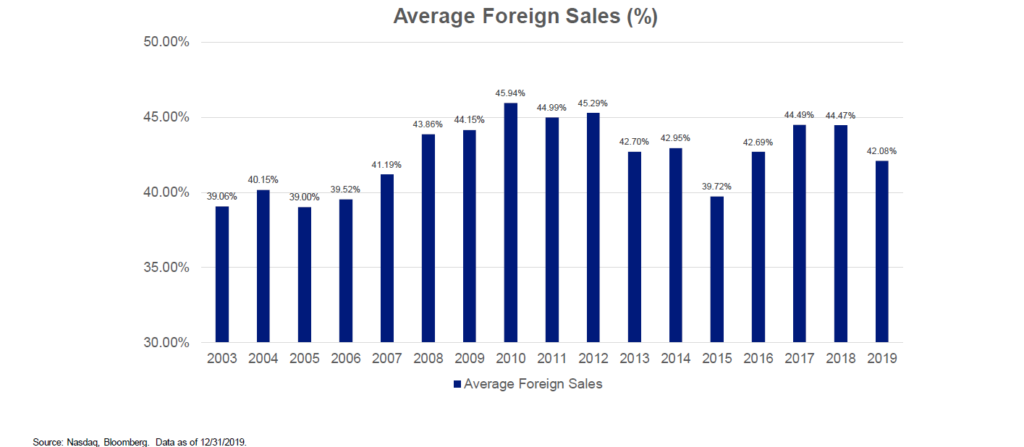
Take Apple for instance. While US sales are significant, a considerable proportion of their revenues are increasingly coming from China, Europe and Asia. As consumption growth in non-US markets picks up, the global presence of Nasdaq 100 companies will position them for new growth opportunities.
3: What’s the difference between Nasdaq 100 and S&P 500?
The S&P 500 holds 500 of the largest US-listed companies and is a broader representation of the US stock market compared to the Nasdaq 100.
In terms of returns, Ryan pointed out that since 2005, the Nasdaq 100 index has outperformed the S&P 500 in 11 out of 15 years, and outperformed the Russell 1000 Growth index in 12 out of the past 15 years. The latter represents the 1000 top companies by market capitalization in the US.
In fact, if an investor had invested $10,000 in the Nasdaq 100 on 31 July 2010, he would have made $65,613 a decade later on 31 July 2020. The same investment in the S&P 500 would have yielded only $36,529.
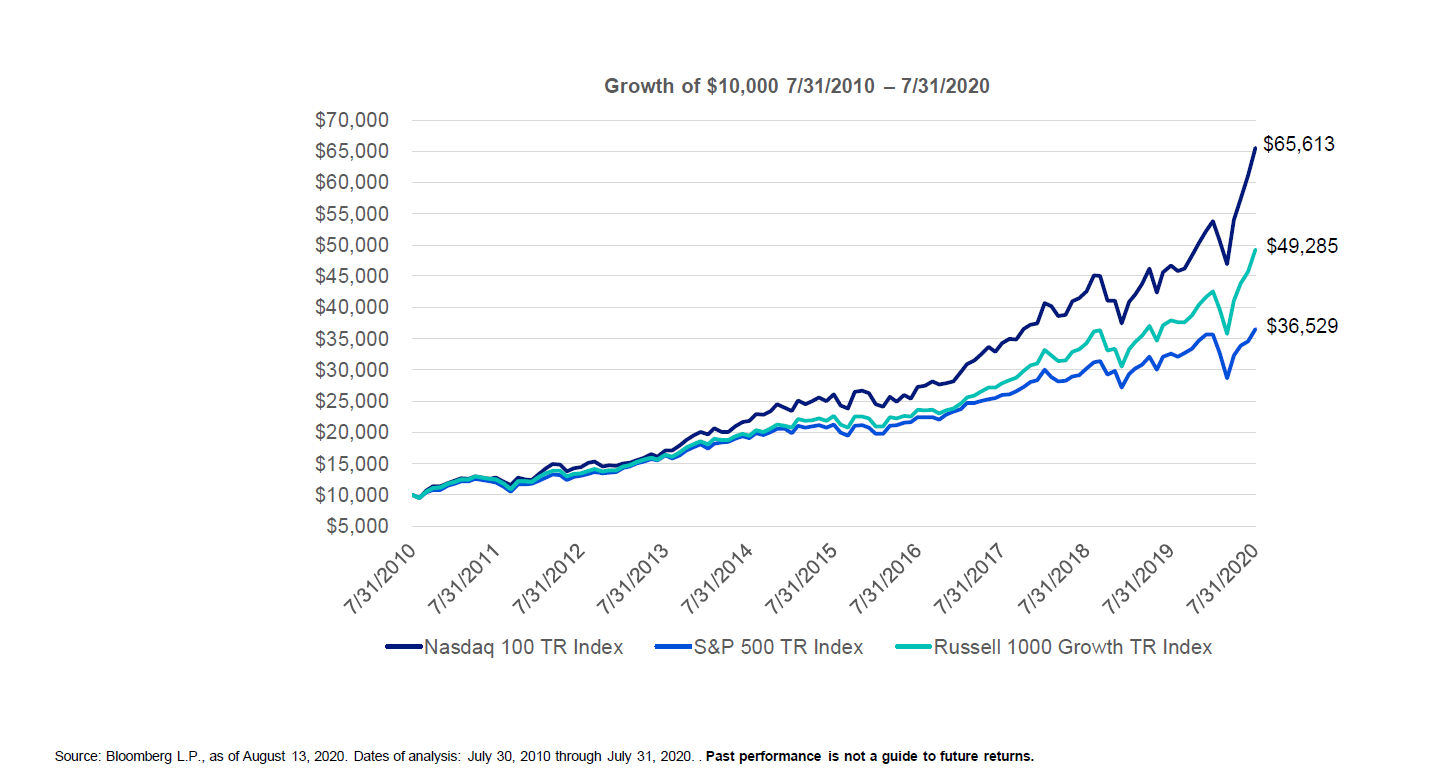
Ryan further noted that since 2008, ETFs tracking the Nasdaq 100 index have generated higher growth rates across revenues, earnings and dividends compared to ETFs tracking the S&P 500 and the Russell 1000 Growth index.
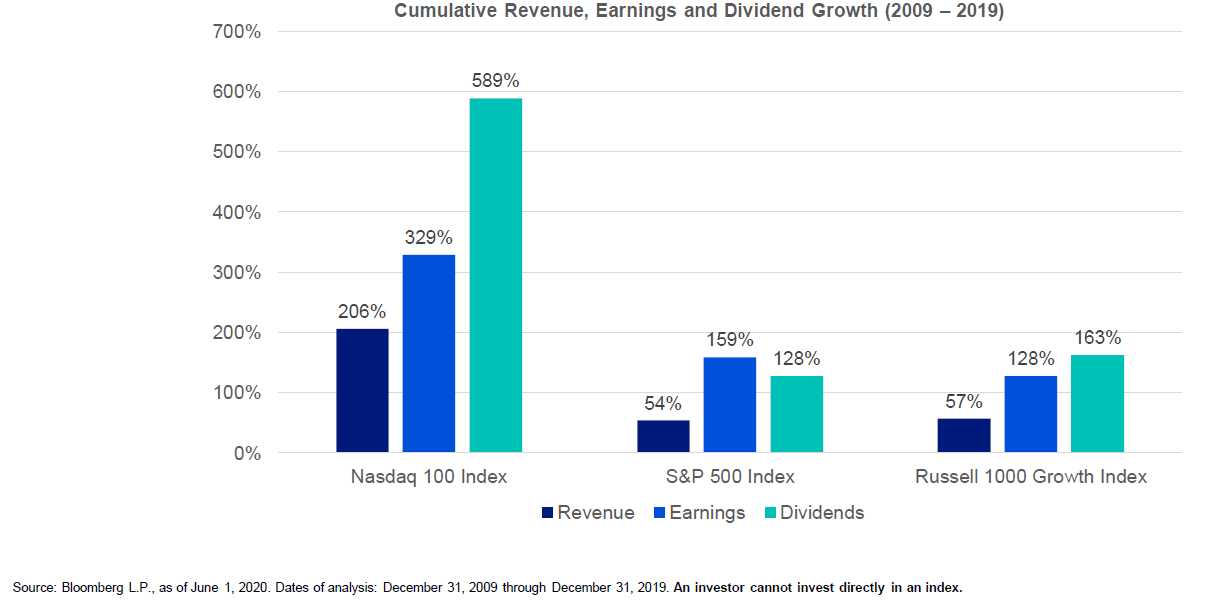
From his perspective, the solid fundamentals behind the Nasdaq 100 index is a key reason why it has significantly outperformed other US large-cap indices.
4: Is the Nasdaq 100 more volatile?
Many investors think that the Nasdaq 100 is a lot more volatile than the S&P 500. The truth is, both indices are “moving very much in tandem”, Ryan noted.
For the past 10 years, both indices have experienced similar volatility. During the March market crash, the S&P 500 even hit a higher volatility level than the Nasdaq 100. The VIX shot up to 85.47 while the VXN reached 84.67. Both VIX and VXN are widely watched gauges or market volatility for the S&P 500 and the Nasdaq 100 respectively.
“It is not true that the Nasdaq 100 has significantly more volatility”, Ryan concluded.
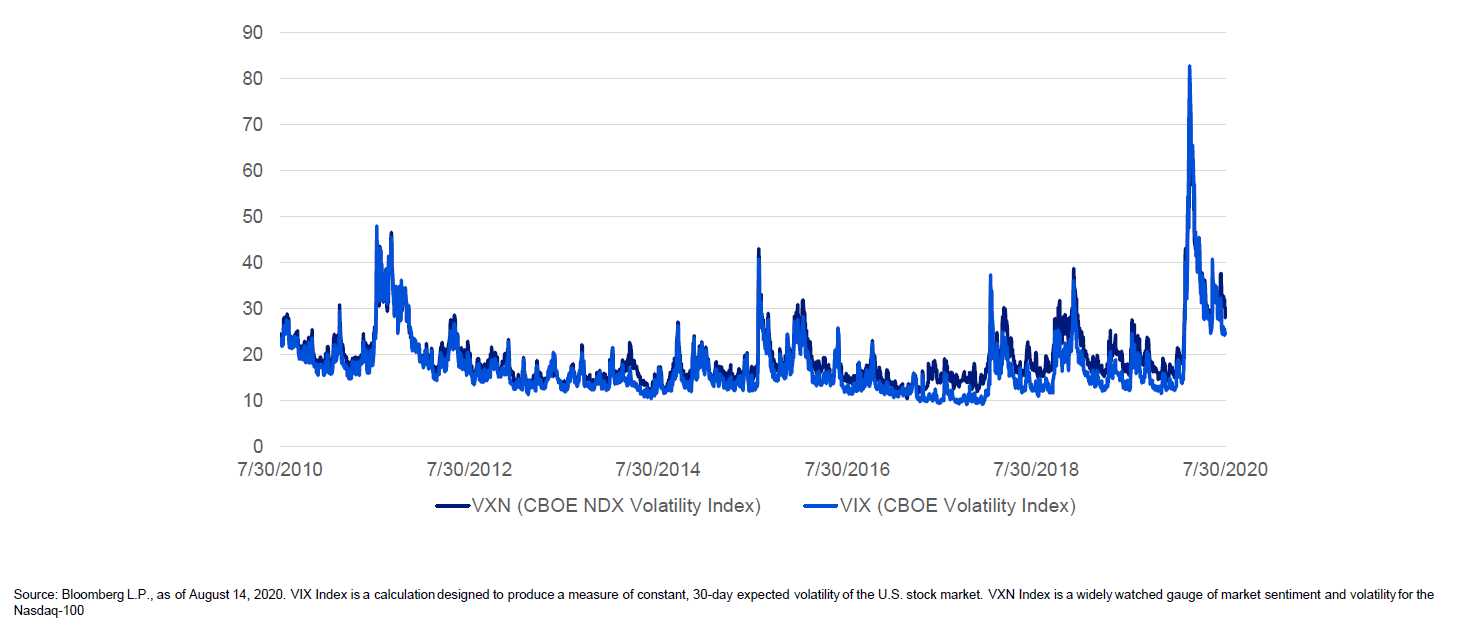
5: Why invest in the Nasdaq 100?
Beyond exposure to large-cap growth companies, investing in the Nasdaq 100 is also an investment in innovation. After all, the index is a who’s who of the world’s most influential and innovative companies. And while the technology focus of the index is certainly a factor, it’s not the only one. Constituent companies in the consumer and healthcare sectors like Netflix and Intuitive Surgical have redefined their respective fields with innovation-first approaches.
Ryan explained that one way to measure innovation is to look at research and development (R&D) investments. Companies within the Nasdaq 100 index spend more dollars on R&D, compared to companies within the S&P 500 and Russell 1000 Growth indices.
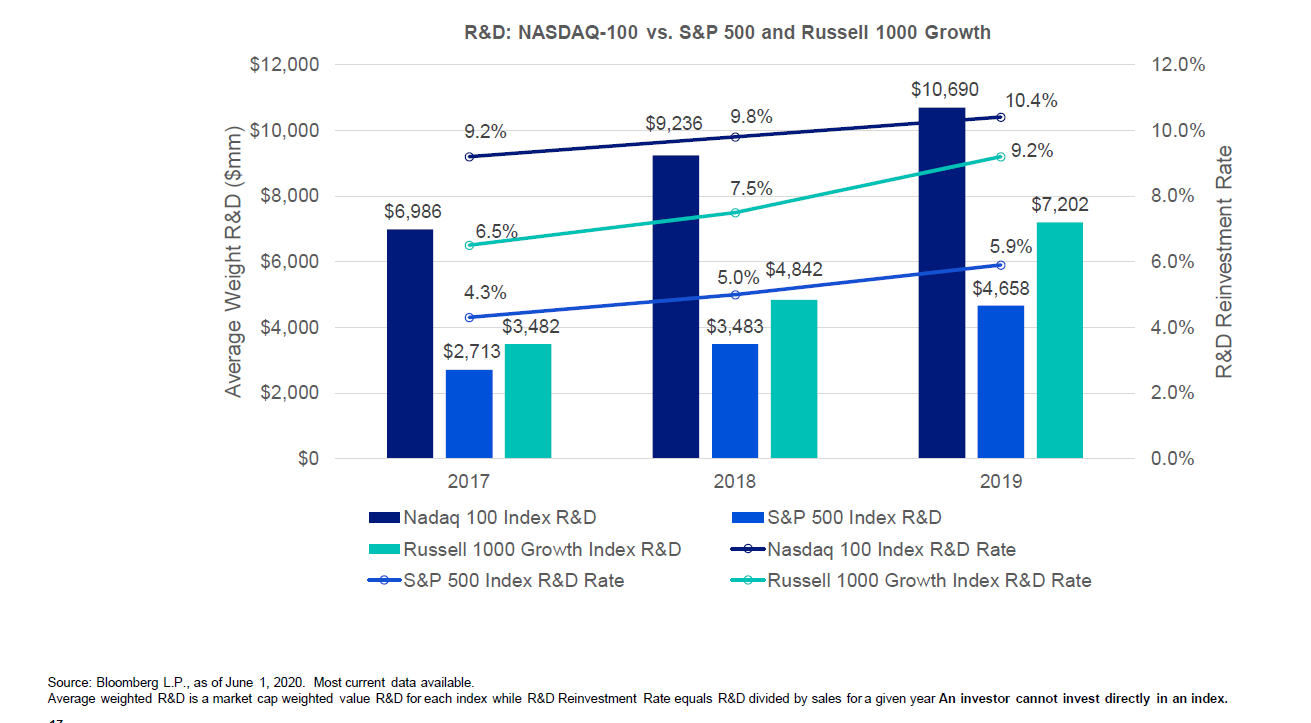
Nasdaq 100 companies also reinvested a larger percentage of sales as R&D. As shown in the chart above, these companies would have reinvested $10 on R&D for every $100 earned in 2019. Meanwhile, S&P 500 companies would have reinvested about $6 on average for every $100 earned.
Has being innovative translated to better financial performance? Very much so, according to Ryan. Nasdaq 100 innovators have seen significant growth in earnings, revenues, and dividend value since 2003. Ryan observed that these companies also held up better than many other S&P 500 companies in the initial COVID-19 downturn.
The risk of a tech bubble may be overhyped
Perhaps the greatest worry investors have over the Nasdaq 100 index is the fear of a second tech bubble. But valuations today are very different from valuations back in 2000, the year the tech bubble popped.
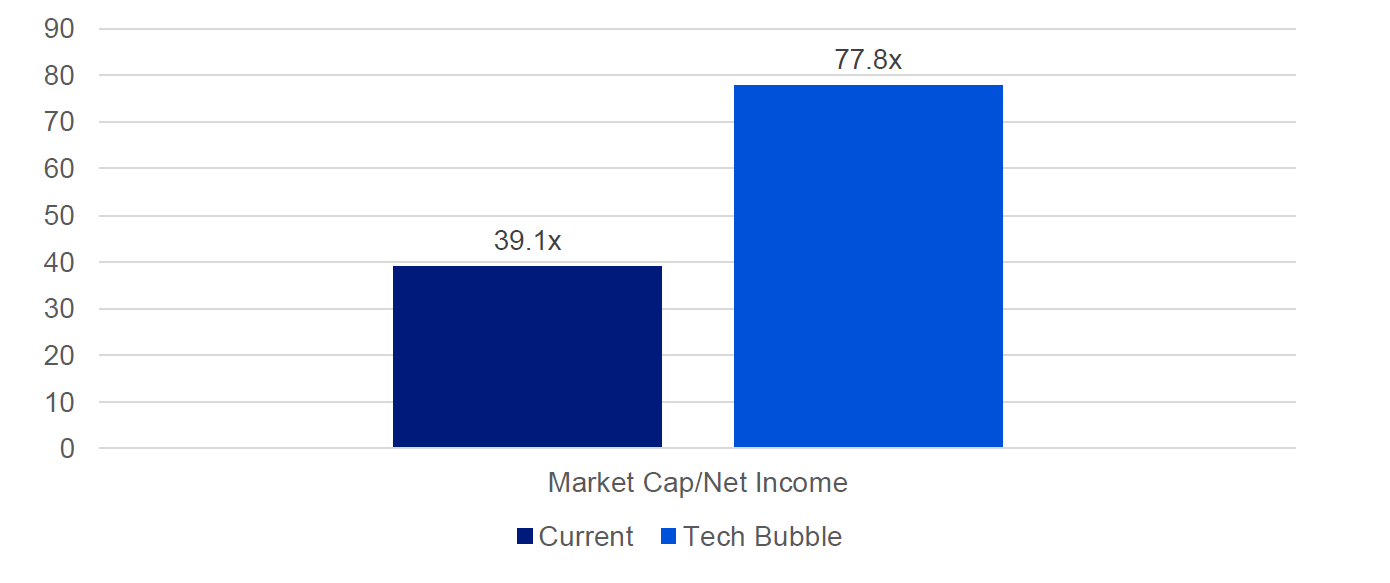
The five largest companies today in the Nasdaq 100 – Microsoft, Apple, Amazon, Alphabet and Facebook – are currently trading at 39.1 times earnings. The five biggest companies in 2000 – Microsoft, Cisco, Intel, Oracle and IBM – traded at 77.8 times. “The five companies today would need to double in one day to be fairly similar to the tech bubble back then,” Ryan noted.
Comparing today’s heavyweights to those of the tech bubble, we are not seeing the same irrational exuberance in 2000, he added. Although the market cap of the five largest companies today is higher than it was at the height of the tech bubble, the higher market capitalization is supported by fundamentals this time.

Sales of the five heavyweights today are six times higher than their counterparts in 2000. Net income has grown almost seven times. Cash held is nearly 12 times more – underscoring these companies’ ability to weather any storms that come their way.
The increase in these fundamental metrics suggests that the higher market capitalization we see today may be warranted. For these reasons, it is unlikely that we are headed to a tech bubble 2.0, Ryan concluded.
Investing in the Nasdaq 100
An investor cannot invest directly in an index. But there are multiple ways still available for investors to gain access, with the ETF route being one of the easiest options.
The Invesco QQQ Trust (QQQ) is the best known ETF tracking the Nasdaq 100. It is the second-most traded and one of the most liquid ETFs in the US. With nearly $80 billion in assets under management, the QQQ has become the fifth-largest ETF, and a go-to large-cap growth fund for many investors.
The QQQ is available through many brokerages, but the simplest and most cost-effective way to get access is probably through Syfe’s Core Equity100 portfolio. Apart from QQQ, you also get exposure to companies in the consumer staples and healthcare sectors, as well as top companies listed in Europe, Australia and Asia. Learn more about the portfolio composition here.
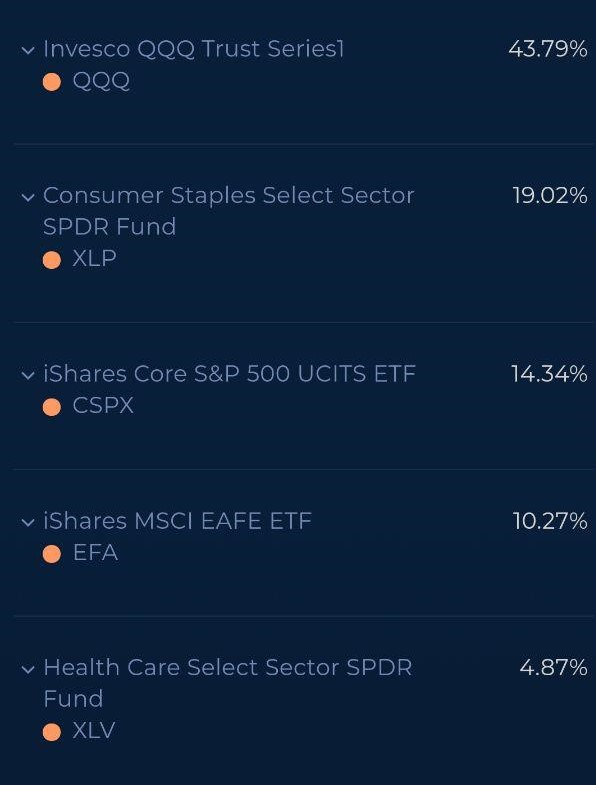
Top 5 Core Equity100 holdings
If you are looking for a pure equity portfolio that can provide higher potential returns over the long term, Core Equity100 is a compelling choice. Our low fees start from just 0.4% per annum, so you get to keep more of your returns. Moreover, Syfe’s $0 brokerage charge and $0 withdrawal fee makes the portfolio ideal for investors who wish to invest regularly.
Ready to get started? Explore Core Equity100 now.






You must be logged in to post a comment.